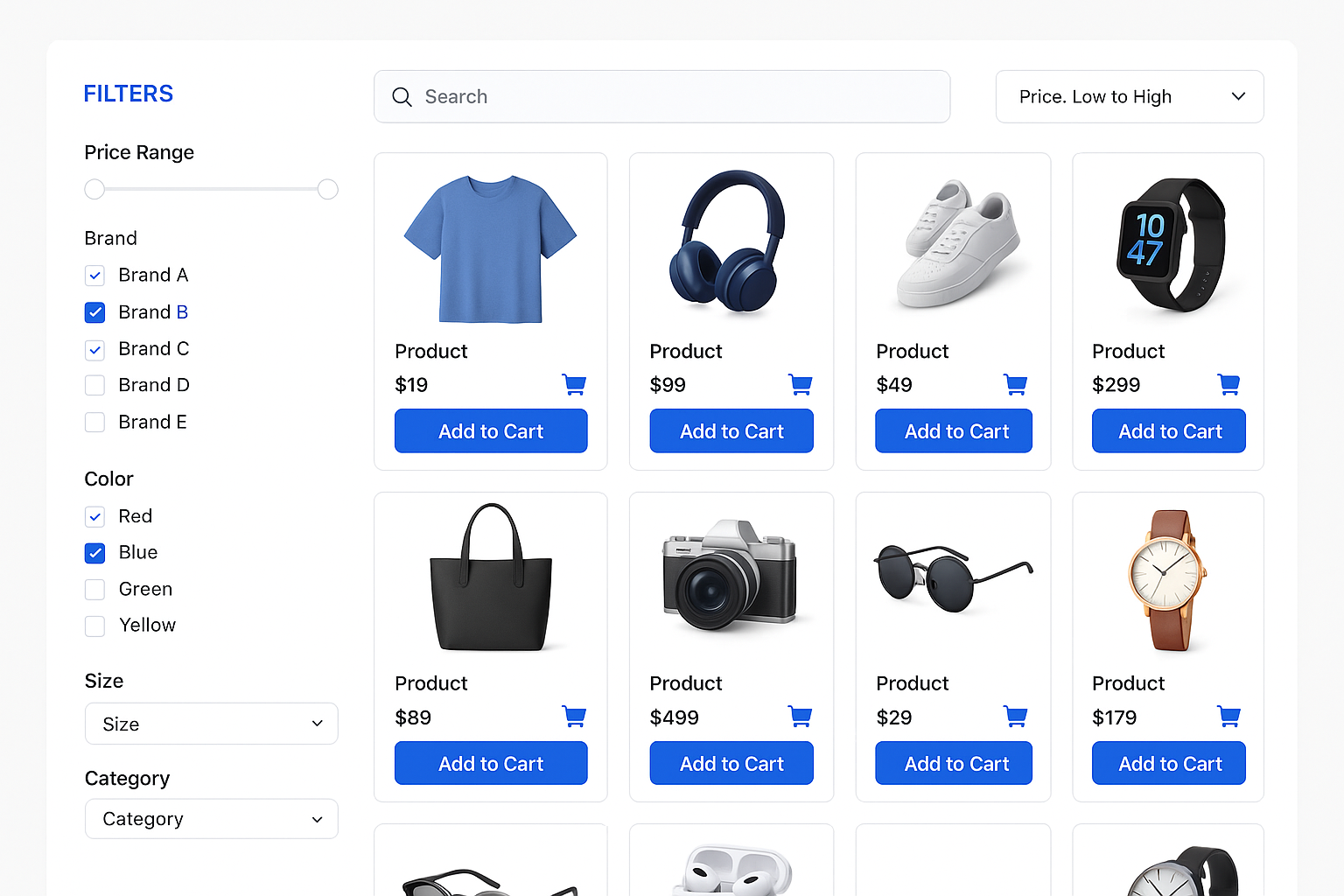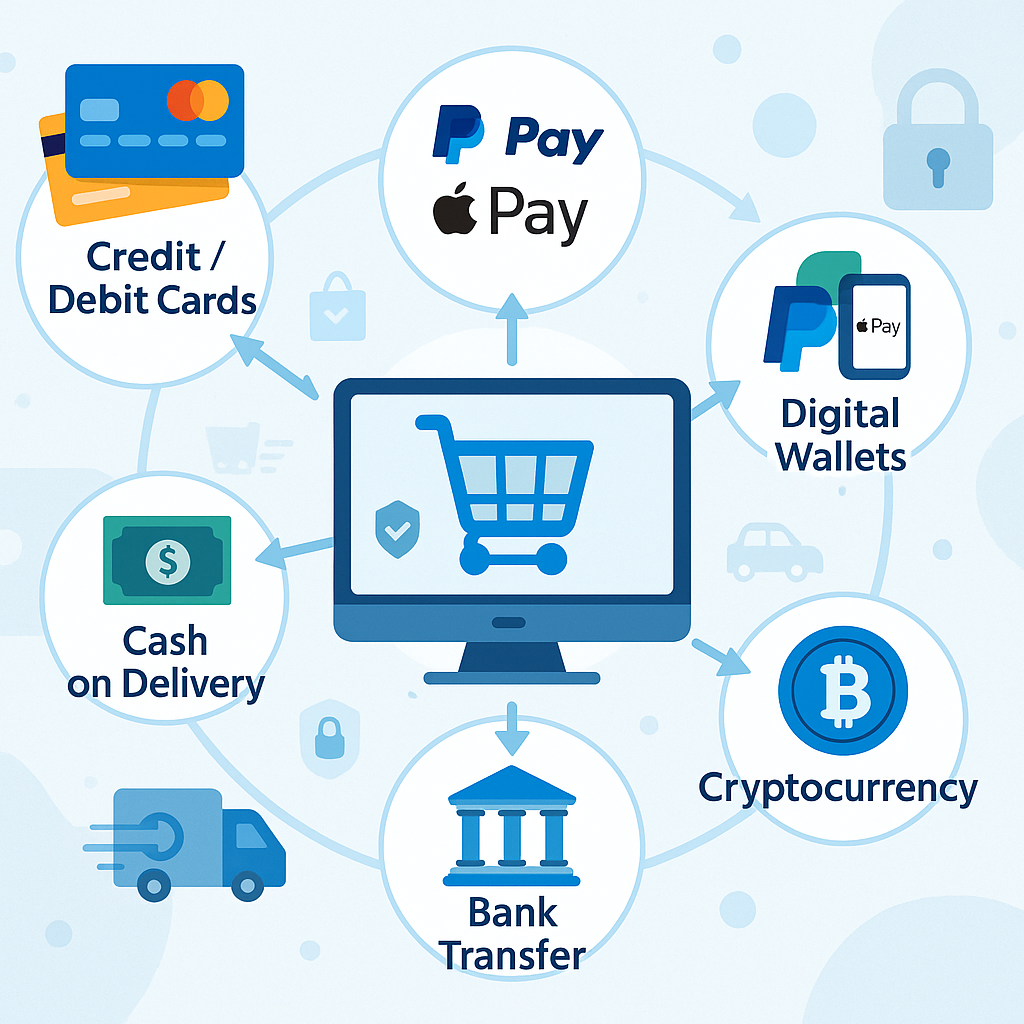Why E-commerce is the Future of Commerce
Online commerce is no longer a trend – it has become the foundation of modern business. According to the latest data, the global e-commerce market continues to grow at a rate of over 10% annually, while entrepreneurs worldwide increasingly recognize the potential of digital sales channels. Modern cities are becoming centers of digital innovation, where local businesses successfully combine traditional commerce with online presence.
The reason for this transformation lies in the fundamental change in shopping habits. Contemporary consumers seek the ability to shop 24/7, fast delivery, easy price comparison, and personalized experiences. They expect to be able to research products online, read reviews, compare options, and complete purchases with just a few clicks.
For entrepreneurs considering launching online sales, it’s crucial to understand that a successful e-commerce site isn’t just a digital version of a physical store. It’s a complex system that must be strategically planned, technically sound, and user-friendly designed. Professional web development requires deep understanding of both technology and customer psychology.
A digital agency can be a key partner in this process, providing the expertise needed to create a platform that not only looks professional but also effectively converts visitors into customers.
Planning Your E-commerce Project – From Idea to Implementation
A successful e-commerce site begins long before the first click on “add to cart.” The planning process is the foundation that determines whether your online store will be profitable or get lost in a sea of competition.
The first step is defining your target audience. You need to precisely determine who your ideal customers are, what their shopping habits are, which devices they use for online shopping, and how much they’re willing to spend. This analysis directly impacts all future decisions – from site design to feature selection.
The next key element is competitor analysis. Study how the most successful e-commerce sites in your industry function. Pay attention to their checkout process, product presentation methods, user navigation, and customer retention strategies. This isn’t about copying, but learning from best practices.
Technical architecture must be planned in advance. Decide whether you’ll use ready-made platforms like WooCommerce or Shopify, or if you’ll need custom web development. Each approach has its advantages – ready-made platforms are faster to implement, while custom solutions provide complete control over functionality.
Budget and timeline are critical factors. Realistic cost planning includes not only initial site development but also ongoing costs like hosting, maintenance, marketing campaigns, and potential feature expansions. A professional digital agency can help create a realistic budget that covers all project aspects.
Key Features of Modern E-commerce Sites

Modern e-commerce sites must have features that not only facilitate purchasing but also build trust and encourage repeat purchases. These features make the difference between amateur and professional online presence.
The product catalog represents the heart of every e-commerce site. Products must be organized into logical categories with advanced filtering options by price, brand, color, size, or any other relevant attribute. Quality photographs from multiple angles, detailed descriptions, and specifications are mandatory elements that directly influence purchase decisions.
Search functionality must be intuitive and fast. Customers often know what they’re looking for and expect to find the desired product within seconds. Advanced search with automatic suggestions, typo correction, and category-based search significantly improves user experience.
Shopping cart and checkout process are critical moments where the highest number of potential customers are lost. The cart must clearly display all items, allow easy addition or removal of products, and transparently show the total price including shipping costs. The checkout process should be as short as possible – ideally three steps or fewer.
Inventory management system must work in real-time. Customers need to know if a product is available, how many pieces are left, or when new stock is expected. This transparency builds trust and reduces customer frustration.
Customer reviews and ratings have become an indispensable part of the e-commerce experience. Allowing customers to leave feedback not only helps future customers make decisions but also provides site owners with valuable information about product and service quality.
Design and User Experience
The visual identity of an e-commerce site must reflect brand values and create an emotional connection with customers. Successful design isn’t just aesthetically pleasing – it strategically guides customers through the purchasing process and minimizes barriers that could lead to site abandonment.
Responsive design is now a necessity, not a luxury. Over 60% of online purchases are made from mobile devices, meaning the site must function perfectly on all screen sizes. Buttons must be large enough for easy tapping, text readable without zooming, and navigation intuitive on touch interfaces.
Colors and typography play a key role in purchase psychology. Different colors evoke different emotions – blue builds trust, red creates urgency, while green associates with safety and naturalness. Typography must be readable on all devices, with text hierarchy clearly defined through different font sizes and styles.
Site navigation must be logical and predictable. The main menu should contain the most important product categories, while breadcrumb navigation helps customers orient themselves and easily return to previous pages. The search bar must be prominently positioned, ideally at the top of the page.
Loading speed directly affects conversions. Research shows that every second of page loading delay reduces conversions by 7%. Optimized images, efficient coding, and quality hosting are key factors affecting site performance.
Trust signals are elements that build customer confidence. Security certificates, warranties, return policies, contact information, and customer testimonials must be clearly highlighted. A professional digital agency knows how to position these elements for maximum impact on purchase decisions.
Technical Aspects – Hosting, Security, and Speed
The technical infrastructure of an e-commerce site is invisible to customers but directly affects their experience and your profitability. Poor hosting can destroy the best design, while insufficient security can lead to loss of customer trust and legal problems.
Choosing a hosting provider is one of the most important decisions. E-commerce sites require greater reliability than ordinary websites because every minute of downtime directly means lost sales. Look for providers who guarantee uptime of at least 99.9%, have fast technical support available 24/7, and offer regular backup options.
SSL certificate isn’t an option but a requirement for every e-commerce site. Customers must see “https” and a lock icon in their browser when entering personal and financial information. Google also favors sites with SSL certificates in search results, making this element important for SEO as well.
Page loading speed is critical for conversions. Image optimization through compression without quality loss, using CDN networks for faster content loading worldwide, and efficient coding are key elements. Professional web development always includes performance optimization as a standard part of the process.
Backup strategy must be automatic and regular. Daily backups preserve data about products, users, orders, and all other critical information. In case of technical problems or attacks, quick restoration can mean the difference between a brief pause and long-term business loss.
Scalability is an often-overlooked aspect that becomes critical when business starts growing. The site must be able to handle increased visitor numbers during promotional campaigns or seasonal peaks without slowing down or crashing. This requires careful architecture planning from the very beginning.
Monitoring and analytics enable continuous site performance tracking. Google Analytics, Search Console, and specialized e-commerce tracking tools provide insights into customer behavior, most popular products, and places where customers abandon the purchase process.
Payment Systems and Logistics

Payment methods are often the last barrier between an interested visitor and a successful sale. Modern customers expect diverse, secure, and fast payment options that match their preferences and habits.
Credit and debit cards remain the most common online payment method. Integration with reliable payment gateways like Stripe, PayPal, or regional solutions enables secure card processing. It’s crucial that the checkout process be simple – customers should enter minimal information and complete transactions in just a few steps.
Digital wallets like PayPal, Apple Pay, or Google Pay are becoming increasingly popular because they enable even faster payment. Customers can complete purchases with one click without needing to re-enter card information. This functionality significantly increases conversions, especially on mobile devices.
Cash on delivery remains an important option in many markets. Many customers, especially older ones, still don’t trust online payments or simply prefer to pay when they receive the product. Enabling this option can significantly expand your target customer base.
Logistics and delivery are equally important as the site itself. Clear definition of delivery zones, costs, and timeframes must be transparently displayed before customers complete their orders. Partnership with reliable courier services enables professional delivery with package tracking capabilities.
Inventory management must be integrated with logistics processes. Automatic product availability updates, customer notifications about order status, and integration with warehouse systems make the difference between professional and amateur approaches.
Returns and complaints must have clearly defined procedures. Customers must know how they can return products, within what timeframe, and under what conditions. A transparent return policy builds trust and is often a factor influencing purchase decisions.
Real-Life Examples
Amazon – Revolution in Online Commerce
Amazon has transformed how we think about e-commerce. What makes Amazon exceptional isn’t just the huge product selection, but also the focus on user experience. Their “one-click” checkout process, personalized recommendations based on previous purchases, and Amazon Prime program with free delivery have set new industry standards.
The key to Amazon’s success lies in continuous optimization. They constantly test different page versions, analyze customer behavior, and adjust the interface based on data. Their review system has become the gold standard – customers trust other customers’ reviews more than marketing materials.
Shopify Success Stories – From Idea to Millions
Many brands we recognize today started as small Shopify stores. Gymshark , a sportswear company, began as a student project in the UK and is now worth over a billion dollars. Their success is based on understanding their target audience – young fitness enthusiasts looking for quality clothing at affordable prices.
Allbirds , a shoe company, built an entire brand around the concept of sustainability and comfort. Their minimalist site design reflects brand values, while clear focus on material quality and environmental responsibility resonates with conscious consumers.
Global Success Stories
Companies like Warby Parker revolutionized the eyewear industry by offering high-quality glasses at affordable prices through direct-to-consumer sales. Their home try-on program solved the main barrier to online eyewear shopping – the inability to try before buying.
Dollar Shave Club disrupted the razor industry with a subscription model and memorable marketing. Their simple, user-friendly website focused on the value proposition rather than flashy design, proving that clear messaging often trumps visual complexity.
What Makes These Sites Successful
Analysis of these examples reveals several key success factors. First, they all put user experience first. Every design or functionality decision is made based on how it will affect the customer.
Second, they understand the importance of data. They continuously track metrics, test different approaches, and adjust strategies based on results. Professional web development today must include tools for tracking and analyzing user behavior.
Third, they build long-term relationships with customers instead of focusing only on one-time sales. Email marketing, loyalty programs, and personalized recommendations are tools that enable customer retention and increase their lifetime value.
The Future of E-commerce
The e-commerce industry is developing at a pace that exceeds expectations. Technologies that were science fiction just a few years ago are becoming standard parts of the online shopping experience today.
Artificial intelligence is already changing how customers interact with e-commerce sites. Chatbots are becoming more sophisticated and can answer complex product questions, help with selection, or resolve order issues. Content personalization based on AI algorithms enables showing relevant products to each visitor individually.
Augmented Reality (AR) technology allows customers to “try” products before purchasing. You can already see how furniture would look in your living room or how certain clothing fits you. This technology significantly reduces return rates and increases customer satisfaction.
Voice commerce is becoming an increasingly important sales channel. Customers use Alexa, Google Assistant, or Siri to order products with voice commands. E-commerce sites must be optimized for voice search queries that are often longer and more natural than traditional text searches.
Sustainability as Competitive Advantage
Customer environmental awareness affects their purchasing decisions. E-commerce brands that can demonstrate their commitment to sustainability – through packaging, delivery, or the product itself – have a significant advantage. This isn’t just a trend but a fundamental change in consumer values.
Blockchain technology could revolutionize transparency in e-commerce. Customers will be able to track the entire product journey from production to delivery, which is especially important for luxury brands and organic products.
A digital agency that understands these trends can help clients prepare for the future instead of just following current standards. Investing in flexible site architecture enables easy addition of new features as technologies develop.
Your Path to Successful Online Sales Starts Here
Creating a successful e-commerce site is a complex process that requires a combination of strategic planning, technical expertise, and deep understanding of customer behavior. From initial idea to launch, every step must be carefully executed for the result to be a platform that not only looks professional but also effectively converts visitors into satisfied customers.
The key to success lies in a holistic approach. It’s not enough to have beautiful design if the site loads slowly, nor is it enough to have a fast site if the user experience isn’t intuitive. Every element – from technical infrastructure to payment systems – must work in harmony to create a seamless shopping experience.
The trends we’ve mentioned show that the e-commerce industry is developing toward greater personalization, better integration with new technologies, and focus on sustainability. Brands that adapt to these changes will have a significant competitive advantage.
If you’re considering launching an e-commerce business or want to improve your existing online site, it’s important to work with partners who understand all aspects of digital business. Professional web development combined with deep understanding of market trends and customer psychology is essential for success.
Our team can help you through the entire process – from initial planning and competitor analysis to design, development, and launch of your e-commerce site. We offer free consultation where we can define a strategy together that matches your goals and budget.
Contact us today and take the first step toward successful online sales. Your customers are already looking for you online – it’s time to find them.



